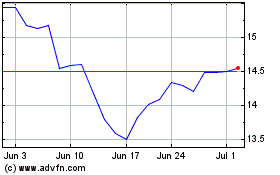Saudi Arabia Backs OPEC Push to Make Steep Oil Output Cuts
November 24 2016 - 9:00PM
Dow Jones News
VIENNA—Saudi Arabia is backing an effort to make the steepest
oil-production cuts possible at OPEC's meeting next week and to
convince producers outside the cartel to help remove almost 2% of
the world's oil supply, people familiar with the matter said.
The ambitious plan is encountering reservations from Iran and
Iraq, the second- and third-largest producers in the Organization
of the Petroleum Exporting Countries, the 14-nation cartel that
controls over a third of global oil production. It also ran into an
obstacle on Thursday when Russia's energy minister said his country
was planning only to hold output steady, not cut.
But the proposal backed by Saudi Arabia, the cartel's biggest
and most influential member, has been pushed to the center of talks
this week here at OPEC's headquarters as the group discusses ways
to shrink production and knock crude prices out of a two-and-a-half
year funk. OPEC's 14 national oil ministers are set to meet
Wednesday to decide on how to cut production to reduce a global
oversupply of oil.
The Saudi-backed proposal would set a production ceiling of 32.5
million barrels a day, the people said. That is more than 1.1
million barrels a day below OPEC's October output and at the top
end of a range of cuts the cartel promised in September.
OPEC agreed to reduce its record output to between 32.5 million
and 33 million barrels a day in September, but its members have
since increased production even more, complicating its calculations
for a cut.
According to the people familiar with the matter, OPEC is also
pushing for Russia and other oil producers outside OPEC to pitch in
by cutting another 500,000 to 600,000 barrels a day of output—the
equivalent of the output a country such as Ecuador. All told, the
OPEC and non-OPEC cuts would remove about 1.6% of global oil
supplies if enacted.
A growing group within the cartel believe only a strong
statement from OPEC and big producers outside the cartel will turn
market sentiment bullish and lift prices. One OPEC delegate said
the cartel's members were discussing cuts of up to 1.3 million
barrels a day from October levels.
The proposal has begun picking up steam in discussions in Vienna
as the cartel's officials study new data showing the imbalance
between oil supply and demand will take longer than they thought to
correct itself without intervention. The amount of oil going into
storage has been increasing in the U.S. and Japan, not falling as
some OPEC members hoped—a trend that keeps the glut going.
OPEC is set to discuss separate cuts with Russia and other
countries outside of OPEC on Monday in Vienna. OPEC specifically
wants Russia to reduce production by 300,000 barrels a day, from
current levels of over 11 million barrels a day, people familiar
with the matter said.
Russian energy minister Alexander Novak said Thursday that
Moscow was in talks with non-OPEC countries about freezing
production at current levels, including Kazakhstan, Uzbekistan and
Mexico. He said a production freeze would effectively be a cut of
200,000 to 300,000 barrels a day for Russia—the world's largest
producer of crude—because the country is planning to bring on new
output soon.
At a gathering in Vienna last month, Brazil told OPEC members
that the public listing of its state-oil giant Petrobras limited
its flexibility in turning off the spigots, while Mexico said its
privatization push could be derailed by such a move, according to
an attendee.
The discussions are beginning to pick up speed and intensity as
OPEC's oil ministers prepare to travel to Vienna.
OPEC still hasn't agreed to a formula for how to apportion the
production cuts. Nigeria and Libya, which have suffered disruptions
due to violence and civil unrest, are likely to be exempted. Iran
has also said it wants an exemption as it builds back the market
share it lost during years of Western sanctions over its nuclear
program.
An Iranian oil official said Tehran has yet to agree to join
OPEC's output-reduction plan.
Laura Mills in Moscow contributed to this article.
Write to Benoit Faucon at benoit.faucon@wsj.com
(END) Dow Jones Newswires
November 24, 2016 20:45 ET (01:45 GMT)
Copyright (c) 2016 Dow Jones & Company, Inc.
Petroleo Brasileiro ADR (NYSE:PBR)
Historical Stock Chart
From Mar 2024 to Apr 2024

Petroleo Brasileiro ADR (NYSE:PBR)
Historical Stock Chart
From Apr 2023 to Apr 2024
